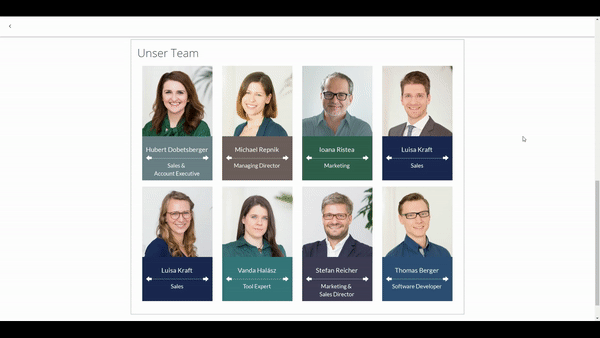A while back I compared Adapt Authoring and Articulate Rise. Since then some amazing new features in both tools have been shipped. Here, I will briefly present the ones I like the most.
Articulate Rise
Rise is a server-based tool and part of Articulate 360. It is hosted by Articulate so it is not possible to use Rise on your companies’ infrastructure.
More interaction types
It is great to see that Rise now supports many more interaction types than at its release. With the Storyline block, for instance, you can embed a Storyline course in your Rise course. To do this, you must upload the Storyline course to Articulate 360 first. You can have as many Storyline content elements on a Rise page as you wish. What’s really great is that you can use different ways to mark a Storyline block as completed. It may be a Storyline trigger, a quiz score or the amount of slides visited. The embedded content scales to the available “screen estate”. Please note that you can only have one Storyline source per block. So for instance, you cannot switch the content dependent on the user’s device. Therefore, you need to make sure that the content created in Storyline actually works on all your supported devices.
Rise also made a new question type available: The matching question allows users to match up items with drag-and-drop. Each block can contain up to ten text pairs.
Completion, tracking and reporting
Now, you can also control the learners’ progress on a page with the continue block. Similar to Adapt’s trickle extension this feature allows you to block scrolling until the content above has been completed.
Another new feature to control the learners’ progress is the "allow forward seeking" option in video blocks. If you disable this option, learners can use the seek bar only within the range of the video that has already been watched. In this way, you can easily ensure that the full video has to be viewed. “Allow forward seeking” can be combined with the continue block so that learners have to complete the video before they can move on.
What is important for your tracking and reporting: For course completion you can now choose out of three options. The first option uses percentage of the course viewed. The second option is to use a quiz result. Finally, you can also use the completion of a Storyline block. Besides SCORM and AICC, Rise also added support for xAPI.

Design and collaboration
If you are a designer you will be pleased to hear that you can now use your own custom fonts in Rise. Simply upload your font in WOFF format to Rise and you can use it for texts and headings.
My favorite new feature, however, is block templates. You can select multiple blocks and save them as a template. The templates can then be reused easily in different courses created with Rise. If you own a team account, these templates can even be shared with your team mates.
Although you can’t export the entire source code, you can send a copy of the course to another Rise user. Simply type in an e-mail address and Rise will create a copy of your course for the specified user. Since it is a copy, you can’t collaborate on the same course, though.
Conclusion
Working with Rise is easy and you can create a nice course within a few hours. Nevertheless, sometimes I wish Rise gave me some more flexibility. For example, it’s possible to change the icon of a block but I can only choose out of four. Why can’t I have my own icons? Or when I use the column grid for images, Rise crops the images automatically. Instead it would be nice if it informed me about the correct size or provided me with an editor in which I can choose the size of the clipping. Overall it’s fun to work with Rise as long as you don’t have strict expectations how your course should behave and what it should look like. With the new interaction types Articulate Rise is a great tool to create basic responsive e-Learning content.
Adapt Authoring
Just as Articulate Rise, Adapt Authoring is a server-based tool to create responsive e-Learning content. It is being developed by leading international companies in the e-Learning industry.
Probably the biggest difference to Rise is Adapt’s open source approach. Since the source code of the Adapt authoring tool is available, it can be installed on your own server. One thing that is new about Adapt is our product Adapt-Ready-to-use. It might be the right fit for you if you would like to be productive as soon as possible. We will install the authoring tool for you and host it in Germany. Our experts will train your staff in workshops, provide customer support, and carry out maintenance and regular up-dates. Furthermore, Adapt Ready-to-use includes a custom theme that will ensure the content you create is always consistent with your corporate design.
Organizing your work
With version 0.5.0 of the Adapt authoring tool you will be able to import a course created with the framework into the authoring tool. This feature also allows you to export content from one authoring tool installation into another. You can use it to collaborate with other companies on large projects or to backup projects and reimport them when content needs to be updated.
Besides that, there have also been minor improvements to the UX of the authoring tool. For instance, you can now collapse articles. This is great if you are working on pages with a lot of content, such as pages with assessments and question banks.
Moreover, you can now add color labels to elements in the page editor. This may be useful for marking certain components in the course as in progress or highlighting all blocks where a certain extension has been enabled.
xAPI support and interactions
Adapt is also extended constantly by new plug-ins created by its active community and available for free. You can use these plug-ins to boost and customize your Adapt tool according to your needs. If you require xAPI support, for instance, you may try this great plugin from J. Pablo Caballero.
LearnChamp as an official contributor to the Adapt project has also published several new plugins, e.g. tables and flashcards. Moreover, we created a feedback avatar that can respond to a learner’s response by showing different emotions. We also provided plugins for game interactions that allow your learners to play memory or match up parts of images.

Due to Adapt’s open source approach, you can also constantly create new features yourself and extend the tool with custom plugins. This means that course authors are not limited to the core features of the tool. As a result, you can create complex designs and tweak layouts for certain device types and sizes.
Conclusion
With its freedom to add custom plugins, the ability to create custom themes to realize complex designs and the power to adjust the content and layout for certain device types and sizes, Adapt is great for complex responsive e-Learning content that works great on all possible devices. As a server-based tool with no limitation on the amount of users, it is also the perfect choice for companies that need a tool that is easy to use for a large group of authors.
Do you need more advice on choosing the right authoring tool for your team? Or would you like to take a closer look at Adapt? Let us know and we are happy to help.


